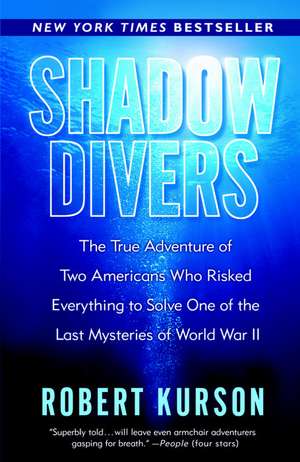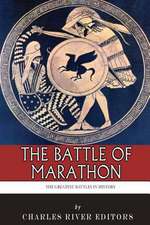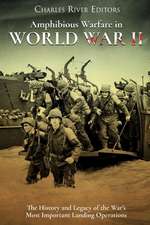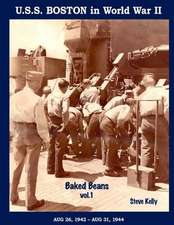Shadow Divers: The True Adventure of Two Americans Who Risked Everything to Solve One of the Last Mysteries of World War II
Autor Robert Kursonen Limba Engleză Paperback – 30 apr 2005
Vezi toate premiile Carte premiată
Listen Up (2004)
For John Chatterton and Richie Kohler, deep wreck diving was more than a sport. Testing themselves against treacherous currents, braving depths that induced hallucinatory effects, navigating through wreckage as perilous as a minefield, they pushed themselves to their limits and beyond, brushing against death more than once in the rusting hulks of sunken ships.
But in the fall of 1991, not even these courageous divers were prepared for what they found 230 feet below the surface, in the frigid Atlantic waters sixty miles off the coast of New Jersey: a World War II German U-boat, its ruined interior a macabre wasteland of twisted metal, tangled wires, and human bones–all buried under decades of accumulated sediment.
No identifying marks were visible on the submarine or the few artifacts brought to the surface. No historian, expert, or government had a clue as to which U-boat the men had found. In fact, the official records all agreed that there simply could not be a sunken U-boat and crew at that location.
Over the next six years, an elite team of divers embarked on a quest to solve the mystery. Some of them would not live to see its end. Chatterton and Kohler, at first bitter rivals, would be drawn into a friendship that deepened to an almost mystical sense of brotherhood with each other and with the drowned U-boat sailors–former enemies of their country. As the men’s marriages frayed under the pressure of a shared obsession, their dives grew more daring, and each realized that he was hunting more than the identities of a lost U-boat and its nameless crew.
Author Robert Kurson’s account of this quest is at once thrilling and emotionally complex, and it is written with a vivid sense of what divers actually experience when they meet the dangers of the ocean’s underworld. The story of Shadow Divers often seems too amazing to be true, but it all happened, two hundred thirty feet down, in the deep blue sea.
From the Hardcover edition.
Preț: 121.46 lei
Nou
Puncte Express: 182
Preț estimativ în valută:
23.24€ • 24.27$ • 19.19£
23.24€ • 24.27$ • 19.19£
Carte disponibilă
Livrare economică 25 martie-08 aprilie
Preluare comenzi: 021 569.72.76
Specificații
ISBN-13: 9780375760983
ISBN-10: 0375760989
Pagini: 416
Ilustrații: 1 16-PP & 1 8-PP PHOTO INSERT
Dimensiuni: 132 x 205 x 24 mm
Greutate: 0.27 kg
Ediția:Rh Trade Pbk.
Editura: Random House Trade
ISBN-10: 0375760989
Pagini: 416
Ilustrații: 1 16-PP & 1 8-PP PHOTO INSERT
Dimensiuni: 132 x 205 x 24 mm
Greutate: 0.27 kg
Ediția:Rh Trade Pbk.
Editura: Random House Trade
Notă biografică
ROBERT KURSON earned a bachelor’s degree in philosophy from the University of Wisconsin, then a law degree from Harvard Law School. After working as a features reporter for the Chicago Sun-Times and Chicago magazine, he moved to Esquire as as a contributing editor. His award-winning stories have also appeared in Rolling Stone, The New York Times Magazine, and other publications. He lives in the Chicago suburbs and can be reached via the Internet at www.robertkurson.com.
From the Hardcover edition.
From the Hardcover edition.
Extras
CHAPTER ONE
THE BOOK OF NUMBERS
Brielle, New Jersey, September 1991
Bill Nagle's life changed the day a fisherman sat beside him in a ramshackle bar and told him about a mystery he had found lying at the bottom of the Atlantic Ocean. Against his better judgment, that fisherman promised to tell Nagle how to find it. The men agreed to meet the next day on the rickety wooden pier that led to Nagle's boat, the Seeker, a vessel Nagle had built to chase possibility. But when the appointed time came, the fisherman was not there. Nagle paced back and forth, careful not to plunge through the pier where its wooden planks had rotted away. He had lived much of his life on the Atlantic, and he knew when worlds were about to shift. Usually, that happened before a storm or when a man's boat broke. Today, however, he knew it was going to happen when the fisherman handed him a scrap of paper, a hand-scrawled set of numbers that would lead to the sunken mystery. Nagle looked into the distance for the fisherman. He saw no one. The salt air blew against the small seashore town of Brielle, tilting the dockside boats and spraying the Atlantic into Nagle's eyes. When the mist died down he looked again. This time, he saw the fisherman approaching, a small square of paper crumpled in his hands. The fisherman looked worried. Like Nagle, he had lived on the ocean, and he also knew when a man's life was about to change.
In the whispers of approaching autumn, Brielle's rouge is blown away and what remains is the real Brielle, the locals' Brielle. This small seashore town on the central New Jersey coast is the place where the boat captains and fishermen live, where convenience store owners stay open to serve neighbors, where fifth graders can repair scallop dredges. This is where the hangers-on and wannabes and also-rans and once-greats keep believing in the sea. In Brielle, when the customers leave, the town's lines show, and they are the kind grooved by the thin difference between making a living on the water and washing out.
The Seeker towers above the other boats tied to this Brielle dock, and it's not just the vessel's sixty-five-foot length that grabs one's attention, it's the feeling-from her battered wooden hull and nicked propellers-that she's been places. Conceived in Nagle's imagination, the Seeker was built for a single purpose: to take scuba divers to the most dangerous shipwrecks in the Atlantic Ocean.
Nagle was forty years old then, a thin, deeply tanned former Snap-On Tools Salesman of the Year. To see him here, waiting for this fisherman in his tattered T-shirt and thrift-shop sandals, the Jim Beam he kept as best friend slurring his motions, no one would guess that he had been an artist, that in his day Nagle had been great.
In his twenties, Nagle was already legend in shipwreck diving, a boy wonder in a sport that regularly kills its young. In those days, deep-wreck diving was still the province of the adventurer. Countless shipwrecks, even famous ones, lay undiscovered at the bottom of the Atlantic, and the hunt for those wrecks-with their bent metal and arrested history-was the motion that primed Nagle's imagination.
Treasure never figured into the equation for Atlantic shipwreck divers in the Northeast. Spanish galleons overflowing with gold doubloons and silver pieces of eight did not sink in this part of the ocean, and even if they had, Nagle wouldn't have been interested. His neighborhood was the New York and New Jersey shipping lanes, waters that conducted freighters, ocean liners, passenger vessels, and warships about the business and survival of America. These wrecks occasionally surrendered a rare piece of china or jewelry, but Nagle and his kind were looking for something different. They saw stories in the Modiglianied faces of broken ships, frozen moments in a nation's hopes or a captain's dying instinct or a child's potential, and they experienced these scenes unbuffered by curators or commentators or historians, shoulder to shoulder with life as it existed at the moment it had most mattered.
And they did it to explore. Many of the deep wrecks hadn't been seen since their victims last looked at them, and would remain lost while nature pawed at them until they simply didn't exist anymore. In a world where even the moon had been traveled, the floor of the Atlantic remained uncharted wilderness, its shipwrecks beacons for men compelled to look.
You had to have steel balls to do what Nagle did in his heyday. In the 1970s and 1980s, scuba equipment was still rudimentary, not much advanced past 1943, when Jacques Cousteau helped invent the system of tanks and regulators that allowed men to breathe underwater. Even at 130 feet, the recreational limit suggested by most scuba training organizations, a minor equipment failure could kill the most skilled practitioner. In searching for the most interesting wrecks, Nagle and the sport's other kings might descend to 200 feet or deeper, virtually begging the forces of nature to flick them into the afterlife, practically demanding their biology to abandon them. Men died-often-diving the shipwrecks that called to Nagle.
Even if Nagle's equipment and body could survive the deep Atlantic, he faced a smorgasbord of other perils, each capable of killing him à la carte. For starters, the sport was still new; there was no ancient wisdom to be passed from father to son, the kind of collective experience that routinely keeps today's divers alive. The sport's cautionary tales, those lifelines learned over beers with buddies and by reading magazines and attending classes, were beaten into Nagle underwater at antihuman depths. If Nagle found himself in some crazy, terrible circumstance-and there were countless of them on these deep wrecks-odds were that he would be the one who would tell the first tale. When he and his ilk survived, the magazines wrote articles about them.
Nagle pushed deeper. Diving below 200 feet, he began doing things scientists didn't fully understand, going places recreational divers had never been. When he penetrated a shipwreck at these depths, he was often among the first to see the vessel since it had gone down, the first to open the purser's safe since it had been closed, the first to look at these men since they had been lost at sea. But this also meant that Nagle was on his own. He had no maps drawn by earlier divers. Had someone visited these wrecks before, he might have told Nagle, "Don't brush against that outboard beam in the galley-the thing moved when I swam by, and the whole room might cave in and bury you if you do." Nagle had to discover all this by himself. It is one thing, wreck divers will tell you, to slither in near-total darkness through a shipwreck's twisted, broken mazes, each room a potential trap of swirling silt and collapsing structure. It is another to do so without knowing that someone did it before you and lived.
The Atlantic floor was still a wilderness in Nagle's prime, and it demanded of its explorers the same grit that the American West did of its pioneers. A single bad experience on a shipwreck could reroute all but the hardiest souls to more sensible pursuits. Early divers like Nagle had bad experiences every day. The sport eagerly shook out its dabblers and sightseers; those who remained seemed of a different species. They were physical in their world orientation and sudden in their appetites. They thought nothing of whipping out a sledgehammer and beating a porthole from the side of a ship, even as their heavy breath hastened nitrogen narcosis, the potentially deadly buildup of that otherwise benign gas in their brains. Underwater, rules of possession bent with the light; some divers cut prizes from the mesh goody bags of other divers, following the motto "He who floats it owns it." Fistfights-aboard boats and even underwater-often settled disputes. Artifacts recovered from wrecks were guarded like firstborn children, occasionally at knifepoint. In this way, early deep-wreck divers had a measure of pirate in their blood.
But not Nagle. In the sport's brawniest era, he was a man of the mind. He devoured academic texts, reference works, novels, blueprints, any material he could uncover on historical ships, until he could have stood in the dockyards of a dozen eras and built the boats alongside the workers. He was a connoisseur of the parts, and he reveled in the life force a boat took on from the interlocking of its pieces. This insight gave Nagle two-way vision; as much as he understood the birth of a ship, he also understood its death. Ordinary divers would come upon a shipwreck and see the mélange of bent steel and broken wood, the shock of pipe and wire as a cacophony of crap, an impediment that might be hiding a compass or some other prize. They would plant their noses in a random spot and dig like puppies, hoping to find a morsel. Viewing the same scene, Nagle repaired the broken parts in his mind and saw the ship in its glory. One of his greatest finds was a four-foot-tall brass whistle from the paddle wheeler Champion, a proud voice that had been mounted on the ship's mast and powered by a steam line. The whistle was majestic, but the most beautiful part of the discovery was that underwater it looked like a worthless pipe. Floating amid the wreckage, Nagle used his mind's eye to watch the ship break and sink. He knew the ship's anatomy, and as he imagined it coming apart he could see the whistle settle, right where that seemingly worthless piece of pipe lay. After Nagle recovered two helms from the British tanker Coimbra in a single day (finding one helm once in a career was rare enough), his photograph was hung-alongside that of Lloyd Bridges-in the wheelhouse of the Sea Hunter, a leading dive charter boat of the time. He was twenty-five.
To Nagle, the value in artifacts like the brass steam whistle lay not in their aesthetics or their monetary worth but in their symbolism. It is an odd sight to see grown men covet teacups and saucers, and build noble display cases to these dainty relics. But to divers like Nagle these trinkets represented exploration, going off the charts. A telegraph on display in a diver's living room, therefore, is much more than a shiny object; it is an announcement. It says, If someone had been to this ship's wheelhouse before me, he would not have left this telegraph behind.
It was only time before Nagle's instinct delivered him to the Andrea Doria, the Mount Everest of shipwrecks. The grand Italian passenger liner had collided with the Stockholm, a Swedish liner, in dense fog off Nantucket Island in 1956. Fifty-one people died; 1,659 were rescued before the liner sank and settled on her side at a depth of 250 feet. The Doria was not a typical target for Nagle. Her location was widely known, and she had been explored by divers since the day after her sinking. But the Doria made siren calls to great wreck divers. She was brimming with artifacts even after all these years: serving sets made of fine Italian china and painted with the ship's legendary Italia logo, silver utensils, luggage, ceramic tiles by famed artists, pewter sherbet dishes, jewelry, signs. In Nagle's day, and even today, a diver could explore the Doria and worry only about having enough stamina to lug home the prizes he recovered.
Had the Doria only her riches to offer, she could not have romanced Nagle so hopelessly. The ship's real challenge lay in exploration. The wreck rested on its side, making navigation dangerous and deceptive. A diver had to conceive the world sideways to make sense of doors on the floor and ceilings to the right. And she was deep-180 feet at her shallowest and 250 feet where she crushed the ocean floor. Men sometimes got disoriented or ran out of air or lost their minds from narcosis and died on the Doria. The wreck was so deep, dark, and dangerous that decades after her sinking, entire decks remained unexplored. Those decks were Nagle's destinations.
Over time, Nagle penetrated the wreck in places long relegated to the impossible. His mantel at home became a miniature Doria museum. Soon, he set his sights on the bell. A ship's bell is her crown, her voice. For a diver, there is no greater prize, and many of the greats go a career without coming close to recovering one. Nagle decided to own the Doria's bell. People thought he was nuts-scores of divers had searched for thirty years for the Doria's bell. No one believed it was there.
Nagle went to work. He studied deck plans, books of photographs, crew diaries. Then he did what few other divers did: he formulated a plan. He would need days, maybe even a week to pull it off. No charter boat, however, was going to take a diver to the Doria for a week. So Nagle, who had saved a good bit of money from his Snap-on Tools days, decided to buy a dive boat himself, a vessel constructed from his imagination for a single purpose: to salvage the Doria's bell.
That boat was the original Seeker, a thirty-five-foot Maine Coaster built in New Jersey by Henrique. In 1985, Nagle recruited five top divers, men who shared his passion for exploration, and he made this arrangement: He would take the group to the Doria at his expense. The trip would be a dedicated one, meaning the divers went with just one objective-to recover the bell.
For the first few days on the wreck, the divers stuck to Nagle's plan. They found nothing. The bell just wasn't there. At that point, even the hardiest divers would have turned back. A single day on the open Atlantic in a sixty-five-foot boat will turn intestines inside out; Nagle and his cohorts had been out for four days in a thirty-five-foot glorified bathtub. But a man is not so inclined to give up when he sees in panoramas. Nagle abandoned the bow of the Doria, where he and his team had been searching, and rerouted to the stern. They would now be flying by the seat of their pants, an improvisation on the deadliest wreck in the Atlantic. No one had ever been to the stern. Yet by conceiving the Doria as a single, breathing organism rather than as detached, twenty-foot chunks of wood and steel, Nagle and the others allowed themselves to look in unlikely places.
On the fifth day they hit pay dirt-there was the Andrea Doria's bell. The men rigged it, beat out the bell's pin with a sledgehammer, and sent up the prize on a heavy-duty lift bag. Shock waves rippled through the diving community. According to their agreement, Nagle owned half the bell, and the other five men owned half; the last man living among them would own it outright. Nagle placed the 150-pound bell into the back of his wife's station wagon and asked her to drive it home.
From the Hardcover edition.
THE BOOK OF NUMBERS
Brielle, New Jersey, September 1991
Bill Nagle's life changed the day a fisherman sat beside him in a ramshackle bar and told him about a mystery he had found lying at the bottom of the Atlantic Ocean. Against his better judgment, that fisherman promised to tell Nagle how to find it. The men agreed to meet the next day on the rickety wooden pier that led to Nagle's boat, the Seeker, a vessel Nagle had built to chase possibility. But when the appointed time came, the fisherman was not there. Nagle paced back and forth, careful not to plunge through the pier where its wooden planks had rotted away. He had lived much of his life on the Atlantic, and he knew when worlds were about to shift. Usually, that happened before a storm or when a man's boat broke. Today, however, he knew it was going to happen when the fisherman handed him a scrap of paper, a hand-scrawled set of numbers that would lead to the sunken mystery. Nagle looked into the distance for the fisherman. He saw no one. The salt air blew against the small seashore town of Brielle, tilting the dockside boats and spraying the Atlantic into Nagle's eyes. When the mist died down he looked again. This time, he saw the fisherman approaching, a small square of paper crumpled in his hands. The fisherman looked worried. Like Nagle, he had lived on the ocean, and he also knew when a man's life was about to change.
In the whispers of approaching autumn, Brielle's rouge is blown away and what remains is the real Brielle, the locals' Brielle. This small seashore town on the central New Jersey coast is the place where the boat captains and fishermen live, where convenience store owners stay open to serve neighbors, where fifth graders can repair scallop dredges. This is where the hangers-on and wannabes and also-rans and once-greats keep believing in the sea. In Brielle, when the customers leave, the town's lines show, and they are the kind grooved by the thin difference between making a living on the water and washing out.
The Seeker towers above the other boats tied to this Brielle dock, and it's not just the vessel's sixty-five-foot length that grabs one's attention, it's the feeling-from her battered wooden hull and nicked propellers-that she's been places. Conceived in Nagle's imagination, the Seeker was built for a single purpose: to take scuba divers to the most dangerous shipwrecks in the Atlantic Ocean.
Nagle was forty years old then, a thin, deeply tanned former Snap-On Tools Salesman of the Year. To see him here, waiting for this fisherman in his tattered T-shirt and thrift-shop sandals, the Jim Beam he kept as best friend slurring his motions, no one would guess that he had been an artist, that in his day Nagle had been great.
In his twenties, Nagle was already legend in shipwreck diving, a boy wonder in a sport that regularly kills its young. In those days, deep-wreck diving was still the province of the adventurer. Countless shipwrecks, even famous ones, lay undiscovered at the bottom of the Atlantic, and the hunt for those wrecks-with their bent metal and arrested history-was the motion that primed Nagle's imagination.
Treasure never figured into the equation for Atlantic shipwreck divers in the Northeast. Spanish galleons overflowing with gold doubloons and silver pieces of eight did not sink in this part of the ocean, and even if they had, Nagle wouldn't have been interested. His neighborhood was the New York and New Jersey shipping lanes, waters that conducted freighters, ocean liners, passenger vessels, and warships about the business and survival of America. These wrecks occasionally surrendered a rare piece of china or jewelry, but Nagle and his kind were looking for something different. They saw stories in the Modiglianied faces of broken ships, frozen moments in a nation's hopes or a captain's dying instinct or a child's potential, and they experienced these scenes unbuffered by curators or commentators or historians, shoulder to shoulder with life as it existed at the moment it had most mattered.
And they did it to explore. Many of the deep wrecks hadn't been seen since their victims last looked at them, and would remain lost while nature pawed at them until they simply didn't exist anymore. In a world where even the moon had been traveled, the floor of the Atlantic remained uncharted wilderness, its shipwrecks beacons for men compelled to look.
You had to have steel balls to do what Nagle did in his heyday. In the 1970s and 1980s, scuba equipment was still rudimentary, not much advanced past 1943, when Jacques Cousteau helped invent the system of tanks and regulators that allowed men to breathe underwater. Even at 130 feet, the recreational limit suggested by most scuba training organizations, a minor equipment failure could kill the most skilled practitioner. In searching for the most interesting wrecks, Nagle and the sport's other kings might descend to 200 feet or deeper, virtually begging the forces of nature to flick them into the afterlife, practically demanding their biology to abandon them. Men died-often-diving the shipwrecks that called to Nagle.
Even if Nagle's equipment and body could survive the deep Atlantic, he faced a smorgasbord of other perils, each capable of killing him à la carte. For starters, the sport was still new; there was no ancient wisdom to be passed from father to son, the kind of collective experience that routinely keeps today's divers alive. The sport's cautionary tales, those lifelines learned over beers with buddies and by reading magazines and attending classes, were beaten into Nagle underwater at antihuman depths. If Nagle found himself in some crazy, terrible circumstance-and there were countless of them on these deep wrecks-odds were that he would be the one who would tell the first tale. When he and his ilk survived, the magazines wrote articles about them.
Nagle pushed deeper. Diving below 200 feet, he began doing things scientists didn't fully understand, going places recreational divers had never been. When he penetrated a shipwreck at these depths, he was often among the first to see the vessel since it had gone down, the first to open the purser's safe since it had been closed, the first to look at these men since they had been lost at sea. But this also meant that Nagle was on his own. He had no maps drawn by earlier divers. Had someone visited these wrecks before, he might have told Nagle, "Don't brush against that outboard beam in the galley-the thing moved when I swam by, and the whole room might cave in and bury you if you do." Nagle had to discover all this by himself. It is one thing, wreck divers will tell you, to slither in near-total darkness through a shipwreck's twisted, broken mazes, each room a potential trap of swirling silt and collapsing structure. It is another to do so without knowing that someone did it before you and lived.
The Atlantic floor was still a wilderness in Nagle's prime, and it demanded of its explorers the same grit that the American West did of its pioneers. A single bad experience on a shipwreck could reroute all but the hardiest souls to more sensible pursuits. Early divers like Nagle had bad experiences every day. The sport eagerly shook out its dabblers and sightseers; those who remained seemed of a different species. They were physical in their world orientation and sudden in their appetites. They thought nothing of whipping out a sledgehammer and beating a porthole from the side of a ship, even as their heavy breath hastened nitrogen narcosis, the potentially deadly buildup of that otherwise benign gas in their brains. Underwater, rules of possession bent with the light; some divers cut prizes from the mesh goody bags of other divers, following the motto "He who floats it owns it." Fistfights-aboard boats and even underwater-often settled disputes. Artifacts recovered from wrecks were guarded like firstborn children, occasionally at knifepoint. In this way, early deep-wreck divers had a measure of pirate in their blood.
But not Nagle. In the sport's brawniest era, he was a man of the mind. He devoured academic texts, reference works, novels, blueprints, any material he could uncover on historical ships, until he could have stood in the dockyards of a dozen eras and built the boats alongside the workers. He was a connoisseur of the parts, and he reveled in the life force a boat took on from the interlocking of its pieces. This insight gave Nagle two-way vision; as much as he understood the birth of a ship, he also understood its death. Ordinary divers would come upon a shipwreck and see the mélange of bent steel and broken wood, the shock of pipe and wire as a cacophony of crap, an impediment that might be hiding a compass or some other prize. They would plant their noses in a random spot and dig like puppies, hoping to find a morsel. Viewing the same scene, Nagle repaired the broken parts in his mind and saw the ship in its glory. One of his greatest finds was a four-foot-tall brass whistle from the paddle wheeler Champion, a proud voice that had been mounted on the ship's mast and powered by a steam line. The whistle was majestic, but the most beautiful part of the discovery was that underwater it looked like a worthless pipe. Floating amid the wreckage, Nagle used his mind's eye to watch the ship break and sink. He knew the ship's anatomy, and as he imagined it coming apart he could see the whistle settle, right where that seemingly worthless piece of pipe lay. After Nagle recovered two helms from the British tanker Coimbra in a single day (finding one helm once in a career was rare enough), his photograph was hung-alongside that of Lloyd Bridges-in the wheelhouse of the Sea Hunter, a leading dive charter boat of the time. He was twenty-five.
To Nagle, the value in artifacts like the brass steam whistle lay not in their aesthetics or their monetary worth but in their symbolism. It is an odd sight to see grown men covet teacups and saucers, and build noble display cases to these dainty relics. But to divers like Nagle these trinkets represented exploration, going off the charts. A telegraph on display in a diver's living room, therefore, is much more than a shiny object; it is an announcement. It says, If someone had been to this ship's wheelhouse before me, he would not have left this telegraph behind.
It was only time before Nagle's instinct delivered him to the Andrea Doria, the Mount Everest of shipwrecks. The grand Italian passenger liner had collided with the Stockholm, a Swedish liner, in dense fog off Nantucket Island in 1956. Fifty-one people died; 1,659 were rescued before the liner sank and settled on her side at a depth of 250 feet. The Doria was not a typical target for Nagle. Her location was widely known, and she had been explored by divers since the day after her sinking. But the Doria made siren calls to great wreck divers. She was brimming with artifacts even after all these years: serving sets made of fine Italian china and painted with the ship's legendary Italia logo, silver utensils, luggage, ceramic tiles by famed artists, pewter sherbet dishes, jewelry, signs. In Nagle's day, and even today, a diver could explore the Doria and worry only about having enough stamina to lug home the prizes he recovered.
Had the Doria only her riches to offer, she could not have romanced Nagle so hopelessly. The ship's real challenge lay in exploration. The wreck rested on its side, making navigation dangerous and deceptive. A diver had to conceive the world sideways to make sense of doors on the floor and ceilings to the right. And she was deep-180 feet at her shallowest and 250 feet where she crushed the ocean floor. Men sometimes got disoriented or ran out of air or lost their minds from narcosis and died on the Doria. The wreck was so deep, dark, and dangerous that decades after her sinking, entire decks remained unexplored. Those decks were Nagle's destinations.
Over time, Nagle penetrated the wreck in places long relegated to the impossible. His mantel at home became a miniature Doria museum. Soon, he set his sights on the bell. A ship's bell is her crown, her voice. For a diver, there is no greater prize, and many of the greats go a career without coming close to recovering one. Nagle decided to own the Doria's bell. People thought he was nuts-scores of divers had searched for thirty years for the Doria's bell. No one believed it was there.
Nagle went to work. He studied deck plans, books of photographs, crew diaries. Then he did what few other divers did: he formulated a plan. He would need days, maybe even a week to pull it off. No charter boat, however, was going to take a diver to the Doria for a week. So Nagle, who had saved a good bit of money from his Snap-on Tools days, decided to buy a dive boat himself, a vessel constructed from his imagination for a single purpose: to salvage the Doria's bell.
That boat was the original Seeker, a thirty-five-foot Maine Coaster built in New Jersey by Henrique. In 1985, Nagle recruited five top divers, men who shared his passion for exploration, and he made this arrangement: He would take the group to the Doria at his expense. The trip would be a dedicated one, meaning the divers went with just one objective-to recover the bell.
For the first few days on the wreck, the divers stuck to Nagle's plan. They found nothing. The bell just wasn't there. At that point, even the hardiest divers would have turned back. A single day on the open Atlantic in a sixty-five-foot boat will turn intestines inside out; Nagle and his cohorts had been out for four days in a thirty-five-foot glorified bathtub. But a man is not so inclined to give up when he sees in panoramas. Nagle abandoned the bow of the Doria, where he and his team had been searching, and rerouted to the stern. They would now be flying by the seat of their pants, an improvisation on the deadliest wreck in the Atlantic. No one had ever been to the stern. Yet by conceiving the Doria as a single, breathing organism rather than as detached, twenty-foot chunks of wood and steel, Nagle and the others allowed themselves to look in unlikely places.
On the fifth day they hit pay dirt-there was the Andrea Doria's bell. The men rigged it, beat out the bell's pin with a sledgehammer, and sent up the prize on a heavy-duty lift bag. Shock waves rippled through the diving community. According to their agreement, Nagle owned half the bell, and the other five men owned half; the last man living among them would own it outright. Nagle placed the 150-pound bell into the back of his wife's station wagon and asked her to drive it home.
From the Hardcover edition.
Recenzii
“An engrossing saga of the suspenseful, intriguing, and dangerous underwater investigation of a Mystery U-boat.”
–CLIVE CUSSLER
“Robert Kurson’s Shadow Divers, about the divers exploring a sunken shipwreck off the New Jersey coast, is a gripping account of real-life adventurers and a real-life mystery. In addition to being compellingly readable on every page, the book offers a unique window on the deep, almost reckless nature of the human quest to know.”
–SCOTT TUROW, author of Reversible Errors
“A tremendously suspenseful story of discovery that comes as close as any book could to providing the reader with approximate sensations of deep sea diving and of life on a submarine at war, and that leaves us with a hell of an impression of the grit, guts, and compassion of a U-boat crew and the two American divers who risked everything to solve the mystery of their last mission.”
–JOHN MCCAIN, author of Faith of My Fathers and Why Courage Matters
“Robert Kurson’s status as an undiscovered pleasure among Chicago readers is about to change, I suspect, in a hurry. Shadow Divers is so culturally astute and terrifyingly suspenseful that it should reach the sort of audience John Berendt, Susan Orlean, Jon Krakauer and Laura Hillenbrand have recently earned. Kurson’s new focus is the larger historical world--a world of U-Boats, forensics and lung-crushing pressure--and his prose is, as always, plain gorgeous.”
–JAMES MCMANUS, author of Positively Fifth Street
“A winning tale exceedingly well told, Shadow Divers takes us on a dangerous and seemingly quixotic descent into the murk–and then, in a fog of nitrogen narcosis, brings us back to the surface with a richer, fuller fathoming of a history we only thought we knew.”
–HAMPTON SIDES, author of Ghost Soldiers: The Epic Account of World War II’s Greatest Rescue Mission
From the Hardcover edition.
–CLIVE CUSSLER
“Robert Kurson’s Shadow Divers, about the divers exploring a sunken shipwreck off the New Jersey coast, is a gripping account of real-life adventurers and a real-life mystery. In addition to being compellingly readable on every page, the book offers a unique window on the deep, almost reckless nature of the human quest to know.”
–SCOTT TUROW, author of Reversible Errors
“A tremendously suspenseful story of discovery that comes as close as any book could to providing the reader with approximate sensations of deep sea diving and of life on a submarine at war, and that leaves us with a hell of an impression of the grit, guts, and compassion of a U-boat crew and the two American divers who risked everything to solve the mystery of their last mission.”
–JOHN MCCAIN, author of Faith of My Fathers and Why Courage Matters
“Robert Kurson’s status as an undiscovered pleasure among Chicago readers is about to change, I suspect, in a hurry. Shadow Divers is so culturally astute and terrifyingly suspenseful that it should reach the sort of audience John Berendt, Susan Orlean, Jon Krakauer and Laura Hillenbrand have recently earned. Kurson’s new focus is the larger historical world--a world of U-Boats, forensics and lung-crushing pressure--and his prose is, as always, plain gorgeous.”
–JAMES MCMANUS, author of Positively Fifth Street
“A winning tale exceedingly well told, Shadow Divers takes us on a dangerous and seemingly quixotic descent into the murk–and then, in a fog of nitrogen narcosis, brings us back to the surface with a richer, fuller fathoming of a history we only thought we knew.”
–HAMPTON SIDES, author of Ghost Soldiers: The Epic Account of World War II’s Greatest Rescue Mission
From the Hardcover edition.
Descriere
Two weekend scuba divers risk everything to solve a great historical mystery surrounding the wreckage of a World War II German U-boat off the coast of New Jersey, its ruined interior a macabre wasteland of twisted metal, tangled wires, and human bones. High school & older.
Premii
- Listen Up Editor's Choice, 2004


















